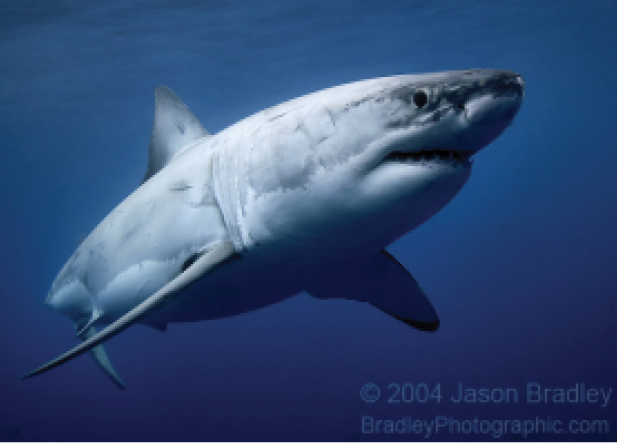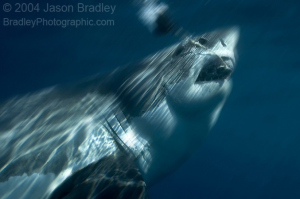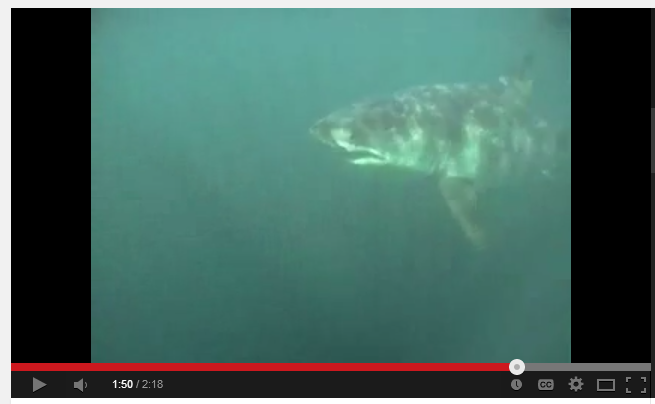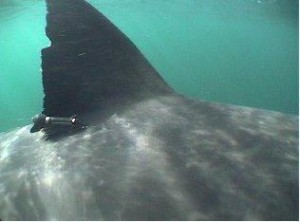White Shark
 Scientific Name: Carcharodon carcharias
Scientific Name: Carcharodon carcharias
White sharks are the largest predatory sharks, and the occasional encounter with humans has made them the most famous. Although they can reach almost 7 m in length, the average shark is closer to 5 m long, and weighs about 700 kg.
Until recently, much of the lifestyle of white sharks was unknown. With satellite technology, we are now learning more about the behaviors of these mysterious creatures.
The following video segment shows how scientists are discovering some of the secrets of the elusive white shark and are learning about the importance of predators in the ocean.
Feeding
- Juvenile white sharks prey on fish, rays, and small sharks (www.ucmp.berkley.edu).
- As white sharks grow and mature, they become large enough to prey on marine mammals, including seals, sea lions, dolphins, and deceased whales, which have a high energy content (www.ucmp.berkley.edu).
- White sharks feed in coastal waters, near sites where their prey haul out to breed, raise their young, and moult.
- Sharks commonly ambush their prey from below by swimming rapidly towards the surface. Estimates are that attacking great white sharks can attain swimming speeds of up to 25 miles per hour. This can cause them to breach from the water during an attack (www.wikipedia.org).
Breeding and Development
- Very little is known about white shark breeding.
- White sharks attain sexual maturity at 15 years of age (www.wikipedia.com)
- The fertilized egg develops in the uterus of the female for over a year before the shark gives birth (www.elasmo-research.org)
- Juvenile white sharks are found in the Southern California Bight, which appears to be an important nursery ground.
Adaptations
- Shark bodies have a torpedo shape to reduce drag in the water. White sharks have stiffer tail fins and more symmetrical bodies than other sharks, which enable them to move more efficiently through the water.
- Sharks accumulate fat stores during coastal feeding phases to fuel long-distance migrations (Del Raye et al. 2013).
- White sharks have a number of the same adaptations for long-distance swimming as tunas (Bernal et al. 2003), including:
- A large gill surface area to enhance oxygen uptake.
- A large heart that pumps a high volume of blood to muscles designed for sustained swimming (red myotomal muscle). Blood transfer to these muscles is highly efficient.
- Shark blood has a high hemoglobin concentration.
- Regional endothermy, which enables sharks to keep a warmer body temperature than the surrounding water. Efficient heat retention systems ensure that body remains at a higher temperature than the ambient water, which enables better muscle function.
- Energy generated by swimming muscles is conserved to keep body temperature high.
- Thunniform swimming, which concentrates power at their tail and minimizes movement of the head and body.
Conservation
Threats
- Human activities are putting sharks at great risk of extinction. In 2009, the International Union for the Conservation of Nature, an international organization that assesses the conservation status of species, placed 64 shark species on the red list. This means that nearly one third of the world’s sharks are at risk of extinction.
- Sharks are harvested for many products. Their meat and fins are used in many cultures as a food source, their skins are used for leather, their liver oil is used for lubricants, cosmetics, and vitamin A, their cartilage is used for medicinal supplements, and their jaws and teeth are sold as collector’s items (The Conservation Status of Pelagic Sharks and Rays, IUCN Shark specialist group 2007).
- Shark finning is largely responsible for the decline of sharks globally. Shark finning involves removing the shark’s fins after it is caught. In many instances, the rest of the shark body is discarded into the ocean. The demand for shark fins has steadily increased over the past decade in response to a rise in popularity of shark fin soup in Asian countries.
- Sharks may also be caught as bycatch, or unintentional catch, during fishing activities. The act of being caught may injure or kill the shark.
- Sharks may also be negatively impacted by habitat degradation in the ocean, pollution, and loss of prey species through overfishing.
- The biology of sharks makes them particularly sensitive to the negative effects of fishing. They are slow growing, late to reproduce, and only give birth to few young, meaning that they are slow to recover from population declines
Conservation Measures
- Shark fishing and activities that harm sharks must be carefully regulated to prevent the extinction of sharks. Regulations must be coordinated on regional, national, and international levels because sharks migrate long distances across political boundaries. Conservation actions in one area can be undermined by contrary actions in another area.
- In 2010, the Shark Conservation Act was passed by the US Congress, which prohibits any person from cutting the fins off of a shark at sea, and from possessing, transferring and landing shark fins. Many additional countries are banning shark finning, but it remains unregulated in international waters.
- Other types of regulations to prevent harm to sharks include live release of sharks caught as bycatch, and the development of fishing gear that is designed to reduce the unintentional catch of sharks.
Tagging and Research
- A range of methods has been used to examine the movements and behaviors of white sharks and the majority of these efforts have focused on near-shore environments.
- Scientists actually know very little about white sharks once they leave the near-shore areas. Studies into their offshore movements have only recently begun.
- The use of satellite tags provides the opportunity to build on existing studies and to obtain a more complete picture of their movements and habitat use.
- Recent satellite tagging data from adults indicates that they are capable of extensive off-shore movements and can travel from California to Hawaii.
- The sharks are studied using pop-up archival tags (PAT).
- These larger tags are designed to release from an animal at a pre-set time – such as 30, 60, or 90 days after the tag’s attached – and float to the surface. A tag then sends samples of its data to the polar-orbiting Argos satellite for about two weeks, the life of its battery. After the battery dies, the data survives so that if the tag is found, researchers can download the entire data set.
- This kind of tag collects information about pressure (for depth of dives), ambient light (to estimate location), internal and external body temperature.


